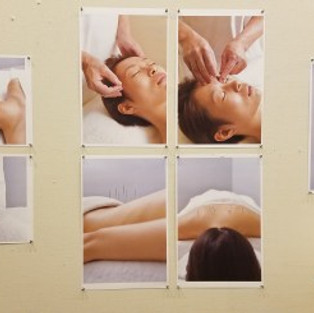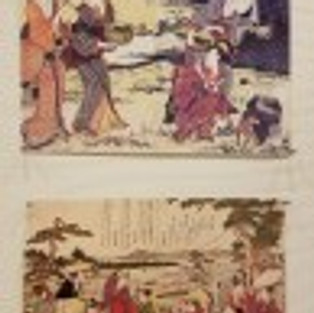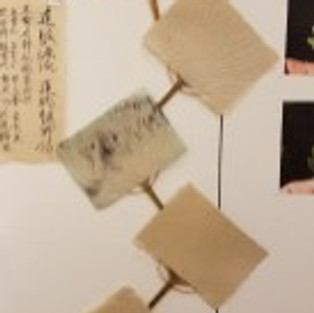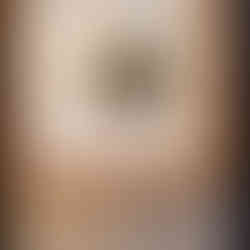Mugwort, Mogusa & Art, the Building Blocks of an International Exchange
- artandcakela
- May 7, 2017
- 4 min read

Mogusa (Refined mugwort. After drying the mugwort leaves, the tiny hairs from the back of the leaf are harvested and put through a grinding process. Mogusa feels soft and billowy to the touch, lighter than cotton.) Photo by Hiroko Okada.
Mugwort, Mogusa & Art, the Building Blocks of an International Exchange
Crafton Hills College Art: Eyes on Healing Weeklong festival
Featured Exhibition Parallels: Medicine = Art
By Jacqueline Bell Johnson
It started with a plant. It has many different names: mugwort, Saint John’s root, mugworth, yomogi, ssuk, moxa, and chernobil -all referring to the genus Artemsia (most commonly in use is Artemsia Vulgaris). It’s a plant that’s found all over the world, and has been used globally as medicine both in ancient cultural practices and in contemporary ones. This plant and its medicinal uses tell a great story of commonality among cultures, great minds thinking alike, and how small this world really is.
Snezana Petrovic, professor and fine art chair at Crafton Hills College in Yucaipa, CA discovered this plant and medicinal practices surrounding it on a trip to Serbia to visit a family member. It is there she met Tomoko Tanuma, who was living in Belgrade at the time. Tomoko, from Tokyo, Japan, has an MFA, is a licensed acupuncturist, has studied psychology, and is also trained in the use of mogusa in her acupuncture practice. Mogusa is a product made from dried and refined mugwort and traditionally is used in conjunction with other therapies such as acupuncture and massage. This chance meeting could not just be mere coincidence. Snezana sought to continue their connection by inviting Tomoko to lead a conference on Medicine and Art at Crafton Hills College.
The conference turned to the festival Art: Eyes on Healing and consisted of workshops, demonstrations, lectures, an exhibition of art and educational and descriptive displays of the tools of healing through acupuncture. The event included 21 artists and healers from around the globe.

Teishin (Small hand-held metal implements used to massage the skin and apply pressure to points on the body.) Made from different metals for different uses, shown are Steel, Titanium, Gold, Silver. Photo by Tomoko Tanuma.
The festival started off with a series of workshops at the district office, demonstrating techniques of Japanese acupuncture, and lecturing on the history of mogusa, and moxibustion demonstrations. While most westerners think of a-lot of needles when it comes to acupuncture, the Japanese tradition is much gentler, often only involving pressure and massage with small metal wands, known as teishin. The teishin are made of different metals for different results, based on density and conductivity, and are used at certain points of the body to align Qi, the body’s life force or energy. Moxibustion is the use of Mogusa on these points to provide a mild heat to the skin, it burns like incense and is aromatic, calming the patient in the process.
The second day of events moved to the Crafton Hills College campus and served as the opening for the exhibition Parallels: Medicine = Art. The exhibition was divided into two spaces. The first was a more medicinal presentation, which included samples of various grades of mogusa and live mugwort plant specimen. Gallery goers were able to touch and smell these samples. A series of photographs illustrated the process of using mogusa on a patient’s skin, and a variety of teishin, incense, and mogusa products were presented. The second area of the gallery was dedicated to art that explored health and healing.
The reception was coupled with performances and workshops by Japanese artists: musician Hiroshi Shimizu and butoh dancer Satomi Akutsu, and their long-time collaborative partner and LA based artist Takeshi Kanemura. The day closed out with lectures Aesthetics of the Mind, Proportional Poems (using math substitutions to create new expressions), and Invoking Ixchel, Mayan Goddess of Healing.
Later on in the week, students had the opportunity to meet with Hiroko Okada, a manga (Japanese comic books) artist who wrote a manga about mogusa’s uses. This was especially a delight to CHC’s manga club, who were able to gain some insight about creating their own manga. Another interesting event was the presentation: Versatility of Mugwort; From Food to Medicine, where attendees could sample both tea and treats made from mugwort, while learning about its uses around the world.

Manga club with Tomoko Tanuma, Snezana Petrovic and Hiroko Okada. Photo Credit Tomoko Tanuma.
The final two days of the festival involved the students reflecting on what they learned by collaborating with guest artists and healers, faculty, staff, and each other to create performances, experimental music, and installations throughout campus. This culminated in a tour at the end of the week, giving participants a chance to talk about their work and what they learned, not just of the topics at hand, but about each other and themselves. The end was bittersweet, as everyone said goodbye after a head-filling week of exploration and exchange. It’s amazing to think it all started with a plant.
Art: Eyes on Healing, an art festival held at Crafton Hills College, March 27-31, 2017
Featuring the Exhibition Parallels: Medicine = Art
Exhibiting Artists:
Camella Kim, Chenhung Chen, Felip Caudet, Genmyo Miyano, Hideo Shinma Sensei, Hiroko Okada, Hiroshi Shimizu, Kazmier Maslanka, Mikio Kawasaki, Ouzi Sha, Saraswati Snezana Petrovic, Takahiro Funamizu, Takeshi Kanemura, Tomoko Tanuma, Dominic Quagliozzi
Additional Lecturers/Presenters/Performers: Gershom aka Dr. Rob Sprijt, Dr. Susana de la Peña, Tomoko Tanuma, Yumiko Kikuchi, Yukiko Shimizu, Katsuhiko Ishikura, Satomi Akutsu, Dr. Gary Williams
#losangeles #CamellaKim #workshop #losangelesartist #ParallelsMedicineArt #GenmyoMiyano #art #OuziSha #YukikoShimizu #DrGaryWilliams #TakeshiKanemura #ArtEyesonHealing #MikioKawasaki #losangelesart #contemporaryart #craftonhillscollege #KatsuhikoIshikura #therapy #artgallery #SaraswatiSnezanaPetrovic #TomokoTanuma #SatomiAkutsu #HideoShinmaSensei #artandcake #artexhibition #medicine #ArtandCakeLA #KazmierMaslanka #YumikoKikuchi #fineart #artists #artist #TakahiroFunamizu #artexhibit #GershomakaDrRobSprijt #ArtandCulture #ChenhungChen #HirokoOkada #lecture #college #healing #DominicQuagliozzi #HiroshiShimizu #DrSusanadelaPeña #FelipCaudet






































































































































